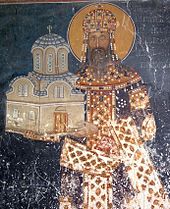Studenica Monastery
The Studenica Monastery ( Serbian Manastir Studenica Манастир Студеница ) is considered to be the cradle of the Serbian kingdom . In addition to the Athos monastery Hilandar and the episcopal church of the Žiča monastery, it is one of the three Serbian Orthodox monasteries that bear the honorary title of Lavra . In 1986, the medieval monastery became a UNESCO - World Heritage declared.
history
In a wooded cirque west of the present-day Opština Kraljevo belonging village Usce located, the monastery was very significant since its inception in the late 12th century and was once the wealthiest of all Serbian monasteries. In its heyday, the very large complex comprised around a dozen churches and palaces and offered space for a few hundred people within the monastery walls. In the early Middle Ages, Serbia lay between two major power blocs, the Frankish West and the Byzantine East. This forced the Serbian rulers to be skilful political maneuvers. At a time when the Byzantine Empire was weakening , Stefan Nemanja succeeded in uniting the Serbian tribes into a Serbian state. His son, who came to be known as Saint Sava , was the first archbishop to preside over the new Serbian Orthodox Church , which became the mainstay of the young Serbian state. Stefan Nemanja, who abdicated six years after the founding of the monastery in favor of his second son Stefan Prvovenčani, went to Hilandar Monastery as monk Simeon on Mount Athos . However, he was buried in the Studenica monastery.
Churches in the monastery
Three churches and the refectory (dining room) are still preserved today on the monastery grounds surrounded by a circular wall.
Mother of God Church
The center of the complex is the single-aisled Church of Our Lady , which has a twelve-sided crossing dome and its design served as a model for many other Serbian churches. The rich decoration on portals, windows and consoles is strongly reminiscent of Western European Romanesque and is rarely found in this opulence in Serbian churches. The artistically less important outside vestibule, which was decorated with frescoes under Stefan Nemanja's grandson, King Stefan Radoslav , covers a little the beautiful late Romanesque west portal, which is adorned by a Madonna enthroned in the arched field as well as by lions and griffins . The interior of the church is covered with wall paintings from three different eras. The oldest frescoes from the early 13th century are only partially preserved, but are among the most valuable works of that century. Presumably a Greek painter from Byzantium worked here who could not use the complicated mosaic technique of the large Byzantine churches, but found a good substitute with his "painted mosaics". The monumental crucifixion scene on the west wall, in solemn gold and azure blue, radiates sublime grandeur; it is the masterpiece of this unknown artist. The most recent paintings in the chancel and in the nave - they show the death of Mary and the monastery founder Stefan Nemanja - were made in the second half of the 16th century , when the Ottomans ruled Serbia.
Royal church
The King's Church , a small Serbian-Byzantine domed building , looks much more modest next to the large Church of Our Lady. King Stefan Uroš II. Milutin had it built as one of his numerous foundations, which are scattered from Serbia via Thessaloniki and Mount Athos to the Holy Land. The two court painters Euthychios and Michael almost completely decorated the church with frescoes depicting the life of Mary, which are among the most successful and harmonious of Serbian fresco painting. The well-preserved murals are small-format, full of details and look cheerful and cheerful, as if drawn from real life: the girls' figures on the north wall, who take part in Mary's introduction to the temple, are particularly graceful. On the south wall they check the temperature of the bathing water for Maria's son.
Nicholas Church
Finally, the monastery complex also includes the St. Nicholas Church , built from rubble stones , of which only a few frescoes from around 1220 have been preserved: on the west wall the depiction of the entry into Jerusalem and women at the tomb of Christ .
Frescoes
In addition to the large-format frescoes of the Church of Our Lady and the realistic depiction of the crucifixion of Christ , the frescoes of the Palai renaissance executed by the Greek painter Michael Astrapes for King Milutin in the royal church are of importance.
Web links
- Entry on the UNESCO World Heritage Center website ( English and French ).
- Official website of the Studenica Monastery (Serbian / English)
- Manastir Studenica on the portal of the Serbian Orthodox Church in Switzerland (Serbian)
Coordinates: 43 ° 29 ′ 11 ″ N , 20 ° 31 ′ 54 ″ E







